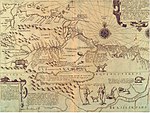File:1656 Sanson Map of Guiana, Venezuela, and El Dorado - Geographicus - Guiane-sanson-1656.jpg
Vai alla navigazione
Vai alla ricerca

Dimensioni di questa anteprima: 770 × 600 pixel. Altre risoluzioni: 308 × 240 pixel | 617 × 480 pixel | 986 × 768 pixel | 1 280 × 997 pixel | 2 560 × 1 994 pixel | 4 000 × 3 115 pixel.
File originale (4 000 × 3 115 pixel, dimensione del file: 3,32 MB, tipo MIME: image/jpeg)
Cronologia del file
Fare clic su un gruppo data/ora per vedere il file come si presentava nel momento indicato.
| Data/Ora | Miniatura | Dimensioni | Utente | Commento | |
|---|---|---|---|---|---|
| attuale | 01:46, 24 mar 2011 |  | 4 000 × 3 115 (3,32 MB) | BotMultichillT | {{subst:User:Multichill/Geographicus |link=http://www.geographicus.com/P/AntiqueMap/Guiane-sanson-1656 |product_name=1656 Sanson Map of Guiana, Venezuela, and El Dorado |map_title=Partie de Terre Ferme ou sont Guiane et Caribane, augmentée et corrigée s |
Pagine che usano questo file
Le seguenti 2 pagine usano questo file:
Utilizzo globale del file
Anche i seguenti wiki usano questo file:
- Usato nelle seguenti pagine di ar.wikipedia.org:
- Usato nelle seguenti pagine di de.wikipedia.org:
- Usato nelle seguenti pagine di en.wikipedia.org:
- Usato nelle seguenti pagine di fr.wikipedia.org:
- Usato nelle seguenti pagine di gcr.wikipedia.org:
- Usato nelle seguenti pagine di hu.wikipedia.org:
- Usato nelle seguenti pagine di la.wikipedia.org:
- Usato nelle seguenti pagine di ru.wikipedia.org:
- Usato nelle seguenti pagine di uk.wikipedia.org:
- Usato nelle seguenti pagine di www.wikidata.org:

